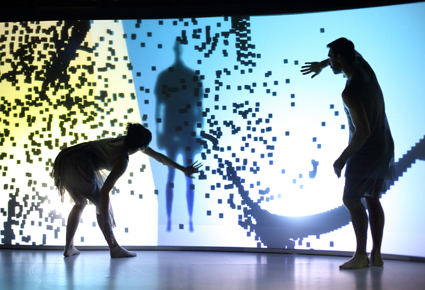mutability: magic & order
anne thompson: leigh warren & dancers, pari passu…touch

Pari passu…touch, Leigh Warren & Dancers
photo Tony Lewis
Pari passu…touch, Leigh Warren & Dancers
PARI PASSU…TOUCH IS AN INTRICATE WEAVE. IT TAKES PLACE WITHIN AN EXQUISITE MARY MOORE DESIGN—A PERFECTLY CIRCULAR WHITE FLOOR WITH TWO WAVE FORM SCREENS OF DIFFERENT LENGTHS POSITIONED NEAR THE BACK OF THE CIRCLE AND SEPARATED BY A GAP. THE WORK BEGINS WITH A LIGHT GLANCING ACROSS THE SCREENS REPEATEDLY, REVEALING THE TEXTURE OF WHAT COULD BE THE MOSAIC OF ROCK ON A SHORELINE.
The lights dim and solid becomes fluid, rock becomes mud. A distant shadowy figure walks towards us, a projection, but then a live male body takes over. The dancers are initially figures behind, appearing to be in the wall—the work presents mutability as order. The screens are revealed to be touch screens. The dancers emerge from behind the wall and return there throughout the piece. The surface changes throughout with beautifully selected projections by Adam Synott. Sometimes the surface shifts in response to the dancers—patterns scatter or collect.
Though the media technology is part of the ‘here and now,’ the references that haunt the work are of some ancient time. My mind wandered to cave paintings and tribal rituals. Some version of our past lurked as a referent. The sound shifted between wind instruments, strings and drums as the dancing changed rhythm and dynamic. Though touch was the declared focus, the dancing away from the screen/wall was a relentless, almost restless, articulation of body in confined space, body in relation to floor and body in relation to other bodies. The dancers performed solos, duets and unison quartets.
Behind/in the wall the movement slowed, opened out, changed shape. The dimensions of the space and wall made the dancers appear larger than life, godlike. At a certain point I was struck by the thought that a cosmology was being represented. I looked up and the lighting bars were in arcs; the heavens appeared. At another point an orange glow dominated the stage, that unmistakable orange that has come to represent Australia. I am struggling to describe the intricate unsettling of solidity, of surface, of depth of field, of time, of symbols and cultural positioning in this dance (Warren has had a long commitment to supporting and working with Indigenous dancers and choreographers).
The duets were a case in point, involving a knotting and unknotting of bodies. There was not the usual rhythm of separation and coming together that often marks this duet form. In the quartet a simple walking forward and back in unison and also the detail of the shoulders and upper backs moving on four hunched dancers was profoundly moving. They were working at the edge of their ability to stay accurate and present. This was thrilling. I found it tantalising to watch a work where referents hovered but had been relegated to the outskirts; where I focused instead on patterns in process and the feelings and meanings these generated. I was reminded of my pleasure in watching Lucinda Childs’ dancers stepping along geometric spatial pathways swinging their arms in the 1980s and was glad of this Australian dance project.
Leigh Warren & Dancers, Pari passu…touch, artistic director, choreographer Leigh Warren, dancers Lisa Griffiths, Bec Jones, Tim Farrar, Jesse Martin, set design Mary Moore, music composition, projection design Adam Synnott, lighting Benjamin Cisterne, garments Alistair Trung, Space Theatre, Adelaide Festival Centre, May 17-26
RealTime issue #109 June-July 2012 pg. 8






